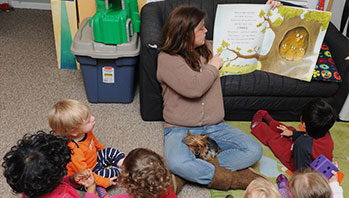- down
- engine
- hill
- machine
- pull
- push
- track
- train
- wheel
MA Standards:
English Language Arts/Literature/RL.PK.MA.1 With prompting and support, ask and answer questions about a story or a poem read aloud.
English Language Arts/Literature/RL.PK.MA.6 With prompting and support, “read” the illustrations in a picture book by describing a character or place depicted, or by telling how a sequence of events unfolds.
Head Start Outcomes:
Literacy Knowledge/Book Appreciation and Knowledge Asks and answers questions and makes comments about print materials.
PreK Learning Guidelines:
English Language Arts/Reading and Literature 6 Listen to a wide variety of age appropriate literature read aloud.
English Language Arts/Reading and Literature 10 Engage actively in read-aloud activities by asking questions, offering ideas, predicting or retelling important parts of a story or informational book.
Read Together: The Little Engine That Could #2

© Commonwealth of Massachusetts, Department of Early Education and Care (Jennifer Waddell photographer). All rights reserved.
STEM Key Concepts: Understand that a ramp, or inclined plane, is a surface with one end higher than the other; Recognize that an object placed on an inclined plane will roll, slide, or stay put; Identify tools and simple machines used for a specific purpose (e.g., ramp, wheel, pulley, lever)
ELA Focus Skills: Active Listening, Interpreting Illustrations, Story Comprehension, Story Elements (Character’s Feelings), Vocabulary, Word Recognition
Before You Read
Reread the story of The Little Engine That Could by Watty Piper. Show children the cover and have them read the title aloud with you. Point to the engine in the cover illustration and point out that the engine is at the front of the train. Ask, Why do you think the other cars are attached to the engine? Guide children to understand that even though all the cars have wheels, they cannot move on their own; they need something to push or pull them on the hill. Act out pushing and pulling a chair across the floor in order to make it move. Say, An engine is a strong machine that can pull the other cars.
As You Read
As you get to the end of the story, pause to focus children’s attention on when the engine pulls the train up the hill. Emphasize the incline in the story.
- Trace the shape of the incline on page 39. Use the words incline and steep as you discuss the hill with children.
- Pause on page 39. Point to the engine and say, What is the engine doing? (pulling the train) In what direction is it heading? Point to the word up on the page. Encourage children to use the word up.
- Pause on page 42. Ask, In which direction is the engine heading now? (down) Point to the word down on the page. Have children describe what it’s like going down a hill.
After You Read
- Hold up an illustration from the book. Invite children to act out the part of the story in the illustration. Encourage them to use the sound the engine makes as it pulls the train up the mountain.
- Invite children to talk about times they’ve pushed or pulled objects. Encourage them to talk about what happens when they’ve pushed objects down ramps and slides.
English Language Learners: Point out that the English word freight means “cargo” and the Spanish word for “freight” is cargo. This can help to bridge understanding of the vocabulary word.
